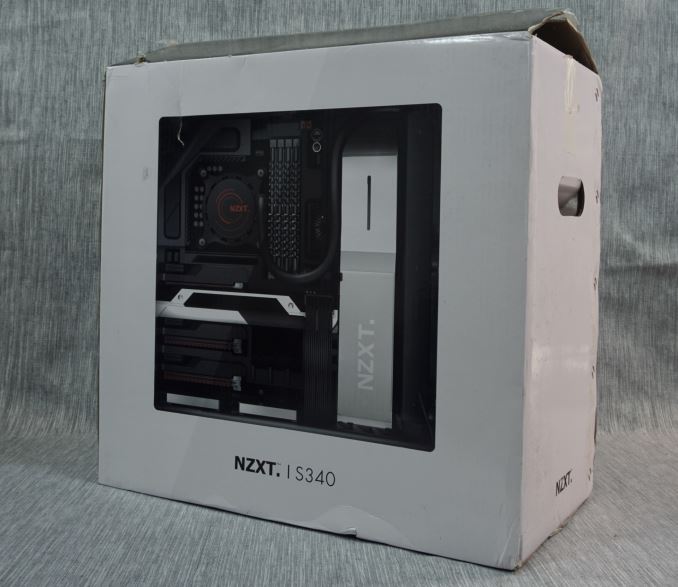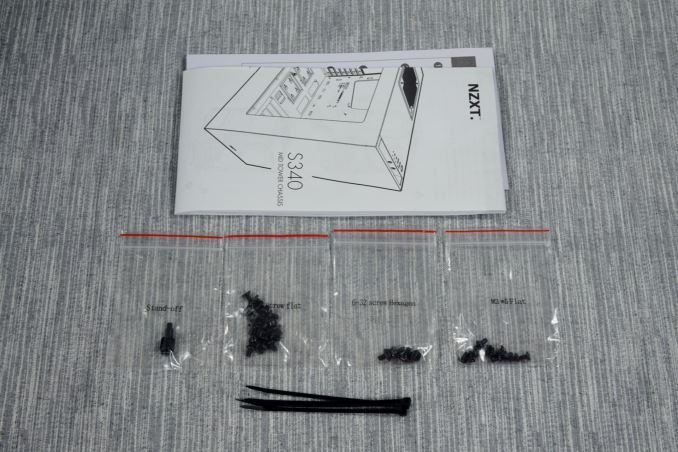The NZXT S340 Case Review
by E. Fylladitakis on July 13, 2015 8:00 AM EST- Posted in
- Cases/Cooling/PSUs
- NZXT
- Case
- ODD-Free

NZXT is a renowned designer of PC cases, offering a wide selection of designs for different tastes and budgets. Even though NZXT has diversified into marketing coolers and PSUs, cases remain the focus of the company, with dozens of designs currently available. Nevertheless, it has been nearly two years since we had a look at any of their newest case designs. In this review, we are going to examine one of their newest products, the S340 in White.
Introduction
The S340 is NZXT’s most recent design and it is taking on a huge bet - to be an entirely metallic case with a price tag of about $80. On paper, the S340 with the MSRP of just $70 has excellent specifications, while it also boasts a metal faceplate and a windowed side panel. It is understood that in order for NZXT to be able to offer all that at such a price, certain sacrifices would have to be made. One of them is the removal of 5.25" bays. "ODD-Free" case designs are becoming more and more common, as the market of optical media is slowly fading and discs are getting closer to meeting the fate of floppy discs and cassettes with each passing day, especially with the price of USB ODD drives being quite low. The lack of ODD support is not the only important thing about the S340 though. We are going to examine NZXT’s latest creation thoroughly in this review.
| NZXT S340 (CA-S340W-W1) | ||
| Motherboard Size | ATX, Micro-ATX, Mini-ITX | |
| Drive Bays | External | - |
| Internal | 2 × 3.5" (internal drive cages) 1 x 3.5" (Bottom frame) 2 × 2.5" (System Area) |
|
| Cooling | Front | 2 × 140 mm or 2 × 120 mm (not included) |
| Rear | 1 × 120 mm (120 mm FN V2 fan included) | |
| Top | 1 × 120 mm or 140 mm (120 mm FN V2 fan included) | |
| HDD | - | |
| Bottom | - | |
| Radiator Support | Front | Up to 280mm |
| Rear | Up to 120mm | |
| Top | - | |
| Side | - | |
| Bottom | - | |
| I/O Port | 2× USB 3.0, 2× USB 2.0, 1× Headphone, 1× Mic | |
| Power Supply Size | ATX | |
| Clearances | HSF | 160 mm |
| PSU | - | |
| GPU | 364 mm (<334 mm if a liquid cooling radiator is installed) | |
| Dimensions | 445 mm × 200 mm × 432 mm 17.52 in × 7.87 in × 17.01 in |
|
| Prominent Features | · 90% Steel Construction · Simple Interior Layout · Compact Size · Kraken™ Ready · ODD Free Design |
|
| Price | $81 incl. shipping | |
Packaging & Bundle
NZXT supplies the S340 in a rather plain cardboard box, with the sole artwork being a picture of an amazingly clean system built inside the black version of the case. The packaging provides ample shipping protection, with thick Styrofoam slabs forming a strong protective shell for the lightweight case.
The bundle of the S340 is spartan, with NZXT providing just the absolute necessary for the assembly of the system. Only a basic manual, black screws and a few short black cable ties are provided.












48 Comments
View All Comments
Qrash - Monday, July 13, 2015 - link
I feel it would be preferrable to use liters instead of cubic meters when listing the volume of a case. For the NZXT S3430 the volume is 38.4 liters which I prefer to 0.0384 cubic meters. For small mini-ITX cases, the volume is often listed in liters.Wardrop - Monday, July 13, 2015 - link
I agree. Litres seems to be more standard in the industry.ES_Revenge - Monday, July 13, 2015 - link
Fitting the monster GPUs of today is one reason... At least AMD is trying to end that trend with the super-short Fury cards. But yeah other than that GPU length has gotten out of hand IMO.powerwiz - Tuesday, July 14, 2015 - link
You would be correct on that. My MSI 980 GTX is about as long as they get in terms of length. I would of been screwed getting it into a smaller case other then the one I recently chose.I think the main reason for them being longer all of a sudden is to spread out the electronics for heat dissipation.
Shadow7037932 - Monday, July 13, 2015 - link
Good to see more cases ditching the 5.25" drive bays. I haven't put one of these drives in a system since 2005. USB DVD RW works well enough in the rare case I need to use it. Even for OS installs, I just use flash drive since it's faster.With that being said, I do wish they made an add-on item for extra 2.5"/3.5" bays to go where the 5.25" drives would have been. Something similar to the removable drive bays we've seen in other cases.
Sushisamurai - Monday, July 13, 2015 - link
So, i'm assuming HSF (first page, by GPU clearance) is in reference to a CPU cooler? It certainly looks like a nice, minimalistic case - cable routing to the bottom right corner of a motherboard would look fairly difficult as I don't think the cables were meant to be run in front of the cable holding panel thing. I wonder though, how much clearance is there from the top fan to the motherboard, as some motherboard heat sinks are really thick and the provided example build picture doesn't really illustrate if that may be a problem.Good catch on the negative pressure airflow problem for cooling the HDD's. Good review/read; if I could make a suggestion, I think you should have also added the Bitfenix prodigy as a temperature/price comparison. Crank out more case reviews!
Samus - Monday, July 13, 2015 - link
It actually is a really nice looking case. I'm glad to see more minimalistic, less gaudy designs. Some of these cases over the years have been ridiculous. Even the likes of Silverstone aren't immune to aesthetic screw-ups (the Raven's, in my opinion, are ridiculous looking, especially when they are internally similar to the fantastic looking Fortress's)jabber - Monday, July 13, 2015 - link
Would look even better with no windows.mr_tawan - Monday, July 13, 2015 - link
At first I thought this is ... "odd-free" design, and wondered what is that 'odd' means ? everything comes in even number ? Then I realized later that it actually is "ODD-free" (as Optical Disc Drive). Take me a few hours to realize lol.BrokenCrayons - Monday, July 13, 2015 - link
I like the overall style of the case, but I personally find it a little bit large though I understand there are some space compromises that have to be made to handle ATX specifications. What I think is a bigger problem is the lack of USB ports. With there being no optical drive, I think an increase in front or top accessible USB ports becomes more important for things like memory card readers, flash drives, or occasional USB ROM drives since file exchanges don't always happen over a network connection.